Dry Skin Is Caused by an Impaired Skin Barrier Function and Can Be Treated with Moisturizers

The Essential Info
What Is Dry Skin? The skin has an outer barrier that, when working correctly, keeps moisture inside the skin. Dry skin develops when the skin’s barrier function is impaired, which causes the skin to lose water, leading to scaly, flaky, and itchy skin.
Dry Skin & Acne: When it comes to acne, dry skin is not our friend. Common sense might point toward drying out the skin helping to “dry up acne,” but as an overall rule, the skin is better able to stay clear when it is balanced. That means when it’s not dry.
Moisturizer Helps: Luckily, dry skin is easily combatted with the application of a moisturizer.

The Science
Dry skin, also called xerosis, is characterized by scaling, flaking, and itching of the skin.
It can range from mild and temporary to severe and chronic.
The outermost layer of the skin provides a property called the barrier function. When the barrier function is healthy, it keeps water inside the skin and keeps harmful substances out. However, if the barrier function is weakened or damaged, water inside the skin evaporates and the skin can become dry and vulnerable.1,2
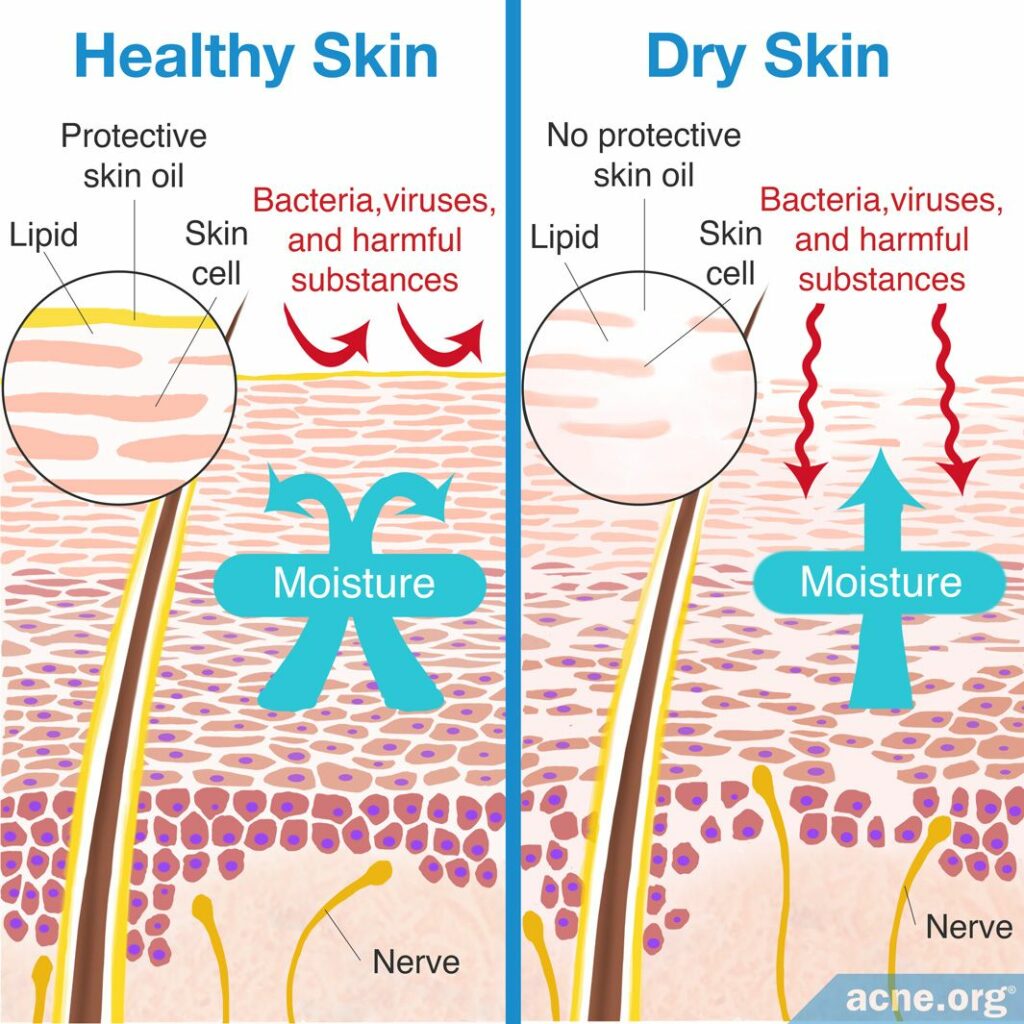
Expand to read more about the skin’s barrier and how it differs in dry skin vs. healthy skin
If we imagine the surface of the skin like a brick wall, the skin cells are the “bricks” and the various fats (lipids) that hold them together are the “mortar.” Together, the bricks and mortar make up the barrier function.
The most important factors in the formation of a healthy barrier function are:
- Natural moisturizing factor (NMF) – keeps cells hydrated: The natural moisturizing factor (NMF) is a collection of substances, including amino acids, sugars, and other substances, that work to keep water inside the surface skin cells that make up the skin’s barrier. In healthy skin, there is a high amount of NMF, and this works to keep the skin cells strong and full of water. In dry skin, there is a low amount of NMF, which causes the skin cells to dry out and shrivel. When skin cells dry out, they cause the skin to appear dry and scaly.
- Connector proteins – holds cells together: Skin proteins called desmosomes normally act to connect skin cells on the surface of the skin. In healthy skin, desmosomes tightly pack skin cells together, and this results in few skin cells flaking off. In dry skin, however, the desmosomes break apart and no longer hold the skin cells tightly. The skin cells then flake off the surface of the skin, which allows for water to escape and causes dry skin.
- Skin oil (sebum) – helps hold cells together:Sebum is found in everyone’s skin, but the production of it is usually elevated in acne-prone skin. In healthy skin, sebum works to keep the skin hydrated by helping the skin cells to pack tightly together, preventing water from evaporating. In dry skin, though, there are two changes to the sebum on the skin:
- Dry skin has less sebum, and the lack of sebum allows for skin cells to flake off the skin, giving the skin a rough appearance.
- Sebum in dry skin possesses a different chemical composition, and this decreases how tightly it can pack skin cells together, affecting how much water can evaporate from deeper areas of the skin into the air.2-4
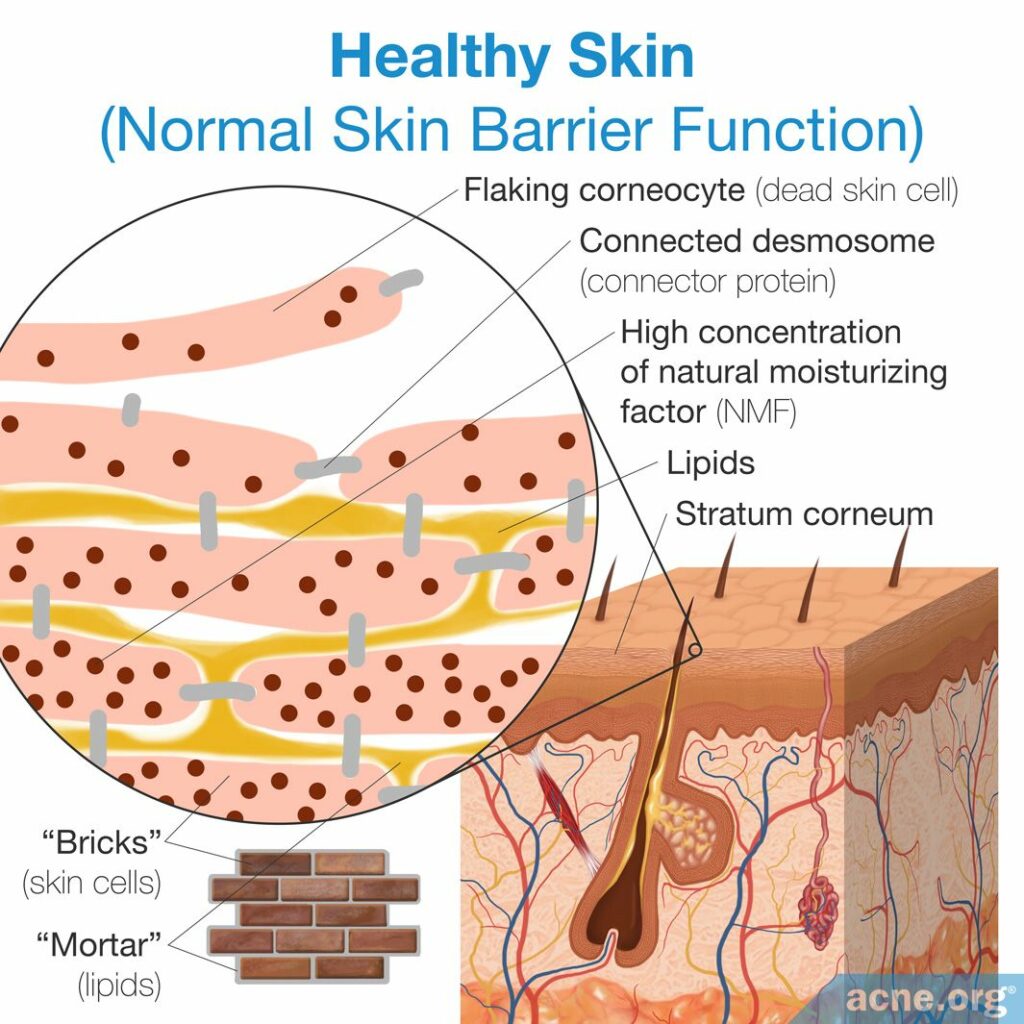
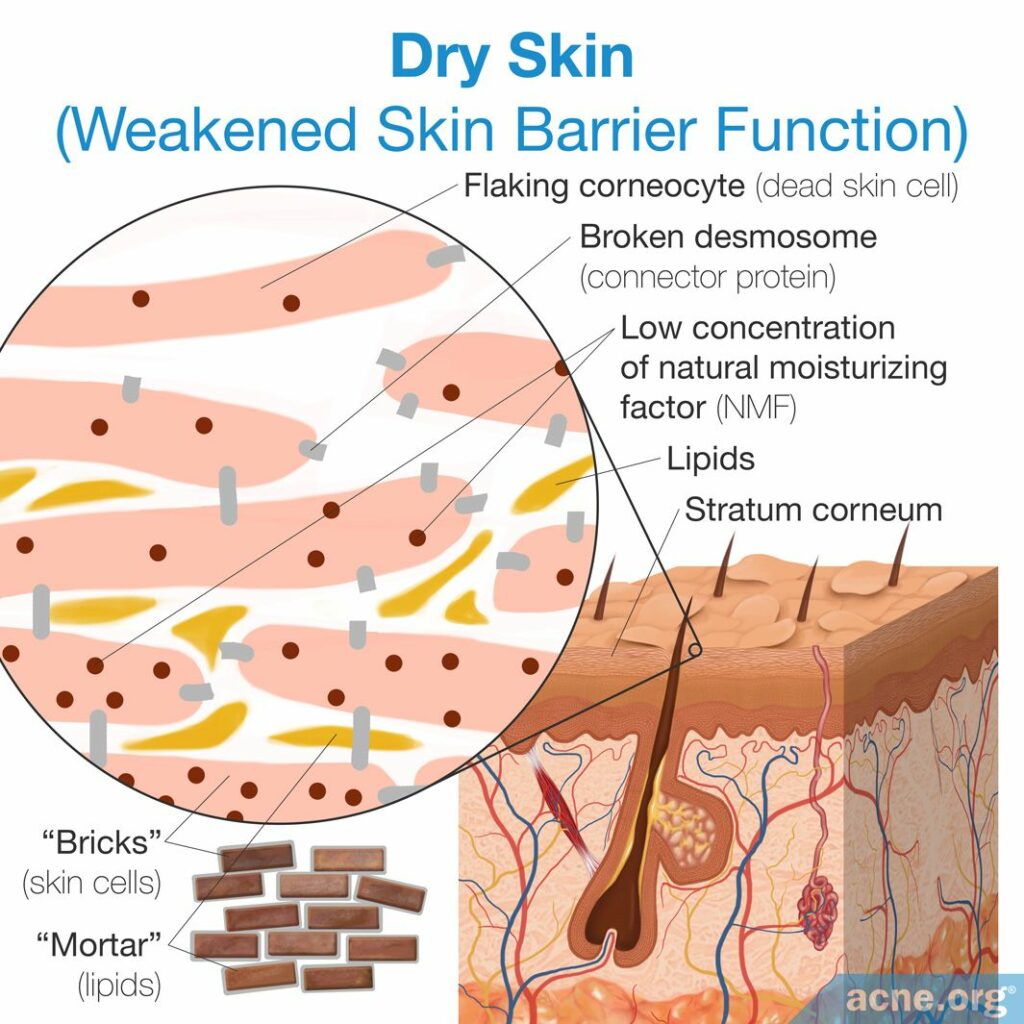
What Causes Dry Skin?
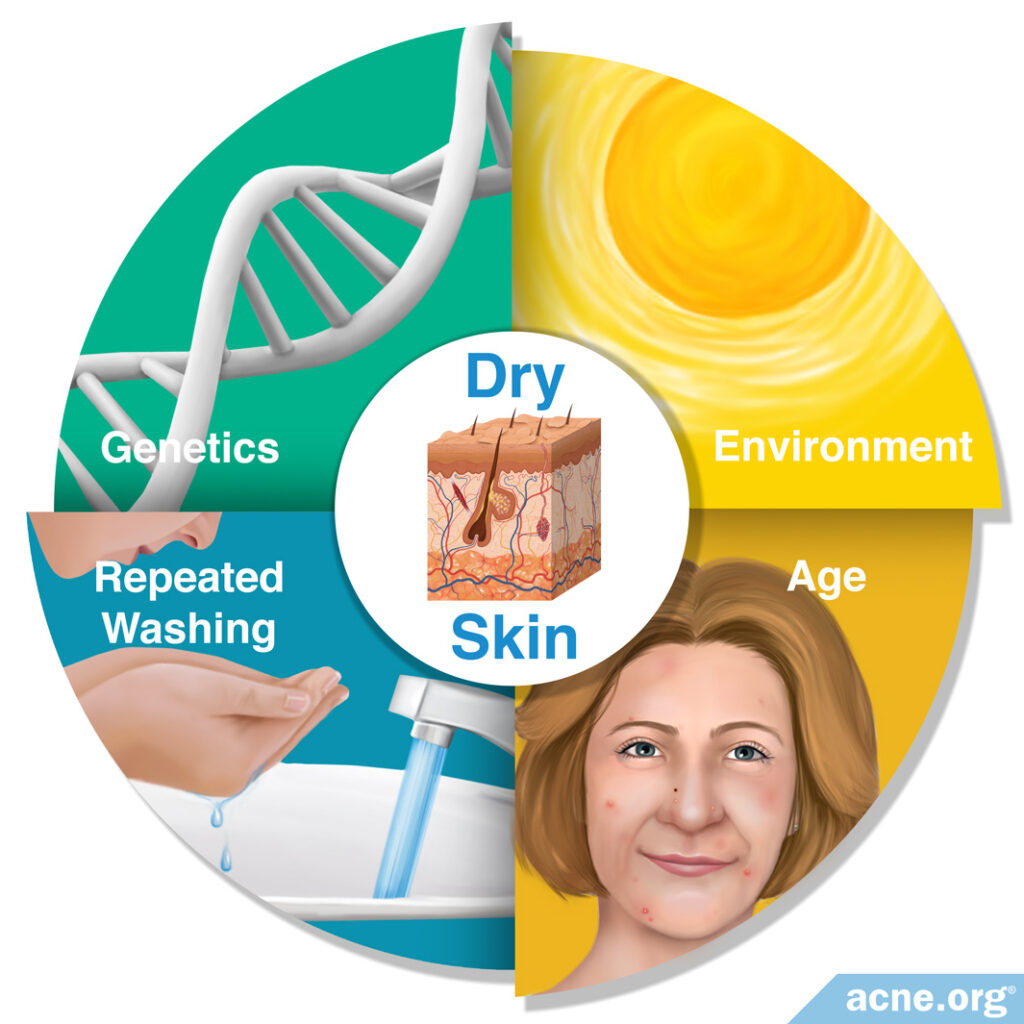
As we have seen, dry skin is caused by an impaired barrier function. There are several factors that can lead to an impaired barrier function:
- Environment: Exposure to cold air, dry air, and sunlight can all damage the barrier function and cause dry skin. Research has found that the development of dry skin is “associated with the seasons, becoming more prevalent in the winter months when the air is dry.”2 This can be particularly true on the face, which is exposed to the environment more than areas of the body that are covered with clothing.5
- Repeated washing: Washing the skin too frequently, especially with harsh detergents and soaps, can damage the barrier function because it can damage skin cells and reduce the amount of skin oil on the skin. Both of these factors weaken the barrier function and can result in dry skin.1,2
- Genetics: The skin’s barrier function is impacted by genetics. This means that if your parents are prone to dry skin, you are more likely to be prone to it.
- Age: As people age, the barrier function becomes weaker. This is why dry skin is more common in older people than in younger people.5
Dry Skin = Sensitive Skin?
Dry skin and sensitive skin may be closely related. Sensitive skin is skin that reacts strongly to skin care products or to dry and cold weather. Research suggests that if you suffer from dry skin, you are also likely to have sensitive skin. Scientists believe that both dry skin and sensitive skin arise from the same underlying cause: impaired barrier function.6
How to Treat Dry Skin
Moisturizers are the main treatment for dry skin. They work by helping to restore and maintain the barrier function.
Thankfully, most major name-brand facial moisturizers are able to reduce skin dryness. When shopping for one, make sure to choose only moisturizers made specifically for the face and look for the words “non-comedogenic” or “won’t clog pores.”
There are three important components that are included in moisturizers: humectants, occlusives, and emollients. Generally, for a moisturizer to be effective it should include at least one humectant and one occlusive ingredient, and if it has an emollient, so much the better.
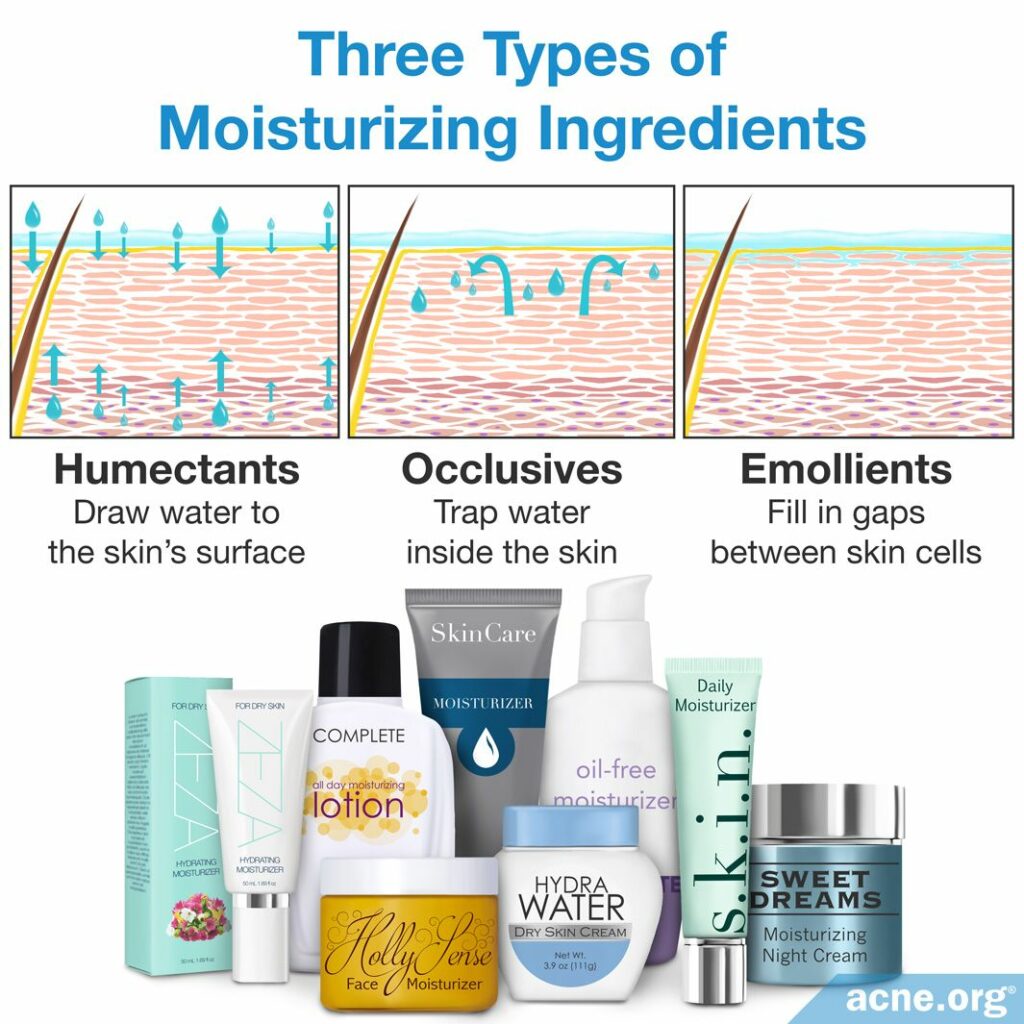
- Humectants: A humectant is a substance that increases the amount of water on the skin’s surface. More water in the topmost skin layers helps to restore the barrier function and improve dry skin.
- Occlusives: An occlusive is a substance that traps water inside the skin, preventing it from evaporating into the air.
- Emollients: An emollient is a substance that fills any gaps that form between skin cells, which helps to keep them tightly joined together and prevent water loss from the skin.
References
- Parker, J., Scharfbillig, R. & Jones, S. Moisturisers for the treatment of foot xerosis: a systematic review. J Foot Ankle Res 10, 1 – 10 (2017). https://www.ncbi.nlm.nih.gov/pubmed/28191040
- Danby, S. G. Biological variation in skin barrier function: from A (atopic dermatitis) to X (xerosis). Curr Probl Dermatol 49, 47 – 60 (2016). https://www.ncbi.nlm.nih.gov/pubmed/26844897
- Harding, C. R. The stratum corneum: structure and function in health and disease. Dermatol Ther 17, 6 – 15 (2004). https://www.ncbi.nlm.nih.gov/pubmed/14728694
- Denda, M. Influence of dry environment on epidermal function. J Dermatol Sci 24, 22 – 28 (2000). https://www.ncbi.nlm.nih.gov/pubmed/11137392
- Proksch, E. et al. Dry skin management: practical approach in light of latest research on skin structure and function. The Journal of Dermatological Treatment 31, 716-722 (2020). https://pubmed.ncbi.nlm.nih.gov/30998081/
- Farage, M. A. The prevalence of sensitive skin. Front Med (Lausanne) 6, 98 (2019). https://www.ncbi.nlm.nih.gov/pmc/articles/PMC6533878/
The post Dry Skin: Causes and Treatments appeared first on Acne.org.
